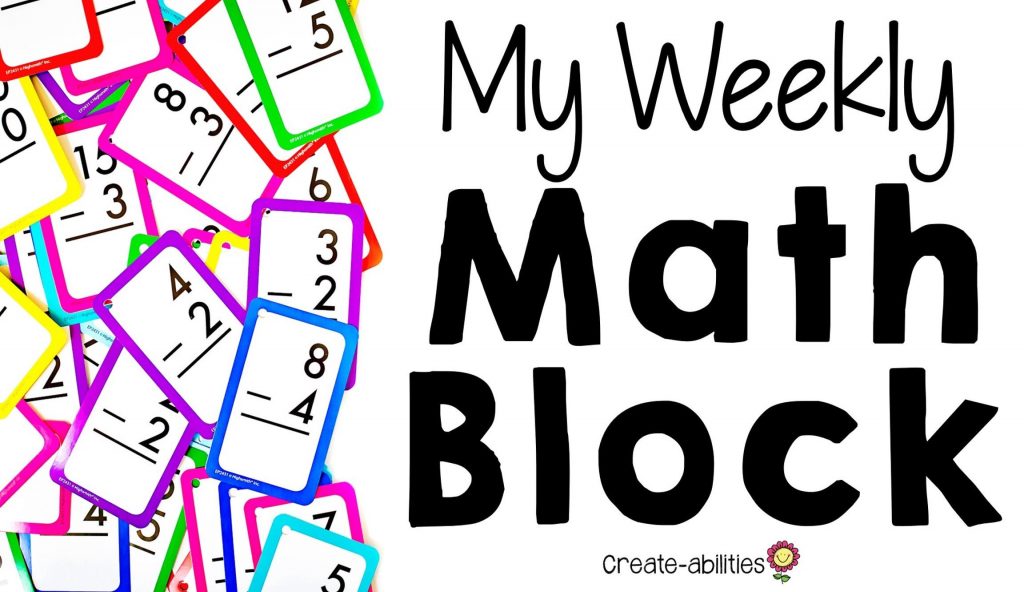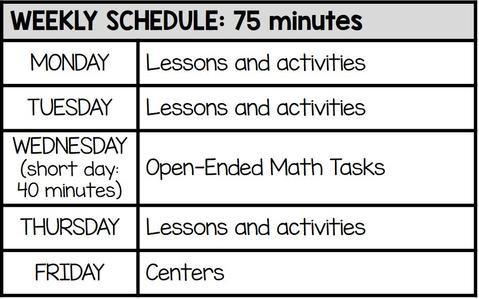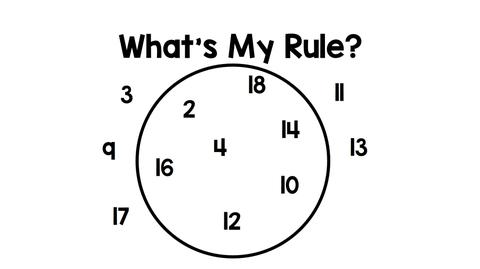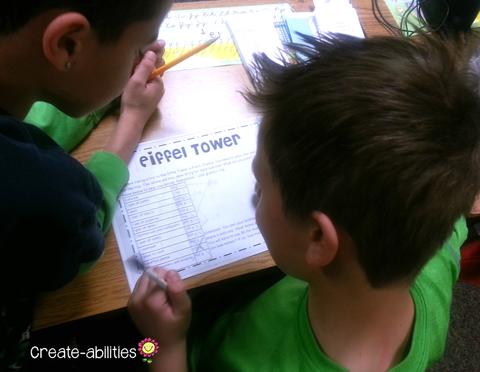
My Weekly Math Block
I often get questions about my schedule. One of the questions I get most is what my math block looked like. It can be confusing and overwhelming to plan out your math schedule. It seems like every year more is added to out plate: weekly math prompts, progress monitoring, Student Learning Objectives, and more! Trying to fit everything in can be a challenge. While my schedule did change slightly from year to year, I tried to keep the overall structure the same the best I could. I am going to show you how I set up my math block as well as some other alternatives you can try!
MY SCHEDULE
The first year I started teaching, I did math in the morning. However, my school scheduled our para’s to come help during our literacy block in the mornings and I had to move math to after lunch.

I strongly believe in doing some type of warm-up or number talk. (You can learn more about number talks here.) This really gets students thinking about math and trying multiple strategies.
This setup also gave me plenty of time to give direct instruction, progress monitor, do hands-on activities, test, reteach, etc. However, during the week my schedule did vary slightly from day to day.

On Monday, Tuesday, and Thursday I would do my normal schedule. However, our short day was on Wednesday. My math time was cut in half. I would do an open-ended math task on those days that tied into whatever topic were were covering. I am absolutely OBSESSED with math tasks. If you want to learn more about those you can go here and here.
Fridays were good days to do centers. That gave the kids a chance to practice the concepts we were covering in class as well as a chance to work with me in small groups. To learn more about how I did centers, you can go here and here.
WHY I ENJOYED THIS SCHEDULE
1. I was able to teach the whole class and small groups every single week.
2. I was able to try a variety of math approaches (number talks, tasks, centers, small groups, mini lessons, etc.) every week which helped reach a variety of learners.
3. My students felt like they were taught a variety of strategies and approaches to math problems. They felt safer to take risks.
4. My students got multiple exposures to the same topic in many different ways.
5. My students weren’t bored during math.
DAILY ACTIVITIES
NUMBER TALKS AND MATH WARM-UPS: 15 MINUTES
I started each day with a warm-up of some kind. I would do a number talk or activity on the board as a class. For example, one I liked to do was called What’s My Rule?

I would draw a circle on the board. Then, one by one, I would begin adding number inside the circle and outside the circle. The numbers inside the circle followed a certain rule. The numbers outside the circle did not. In the example above the numbers are all even (or multiples or two depending on your grade.) I could use this with a variety of topics: numbers that rounded to 50, equivalent fractions, multiples, etc. It was very fun and motivating.
WHOLE GROUP INSTRUCTION: 15-45 MINUTES (DEPENDING ON THE TOPIC)
I then taught my whole-group instruction. This is where I used direct instruction to teach the core concepts of the day. I would use my whiteboard and the students would follow along with their math journals. I tried to make this hands-on and engaging. We had interactive number lines where the students held a rope and clipped numbers in place. We used math manipulatives. We played games. Anything I could do to get the kids more involved.
SMALL GROUPS/INDEPENDENT PRACTICE: 15-45 MINUTES (DEPENDING ON THE TOPIC)
After the students had practice with me, they would get some independent or small group practice. This was when they filled out a graphic organizer, completed a worksheet, played a game, did a choice from their math menu, etc. I would walk around and monitor as needed.
RETEACHING: 15-20 MINUTES (DEPENDING ON THE TOPIC)
During the small group and independent practice time, I would pull kids back to my table to reteach or scaffold. I would ask the kids to show me a 1, 2, or 3 on their fingers at the end of the lesson. 3 meant they understood the concept and didn’t need help. 2 meant that they think they got it, but still needed to practice. 1 meant they were very confused and needed to go over it again with me at the table. This was not a shameful experience. We constantly talked about how learning is a process and that it can be difficult. The kids would come work with me as I retaught concepts until they felt like they understood it enough to work on their own.
EXIT TICKETS
About 3 times a week, I would have my students do an exit ticket. They are the quickest and most effective way I have found to assess your students understanding of core concepts. I have a blog post here that you can read more about how I used them in my room.
It may seem hard to try and fit everything in (and it is!). Using this schedule I was still able to get through everything I needed to before the end of the year. We didn’t have a solid math program most of the time I was teaching. My last year I helped pilot Go Math and Math Expressions. My district eventually choose Math Expressions. Even with a math program, I think you carve out time for centers and tasks. You can do tasks and centers at a different time than your regular math block if you don’t feel like you can get everything done.
I hope you find this useful! Thanks for all you do!
Blog Categories
Meet the author



